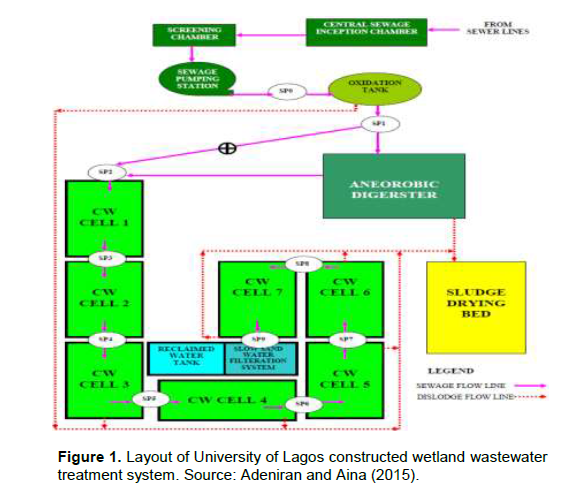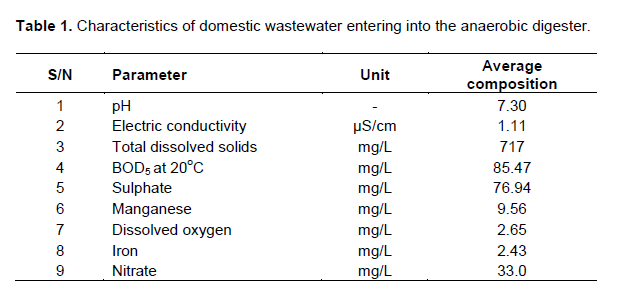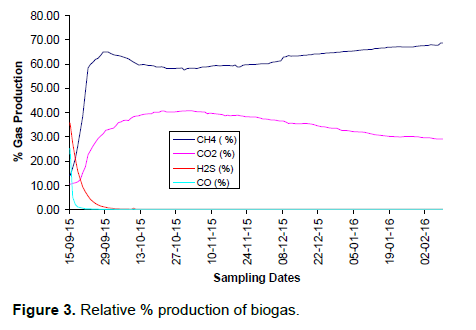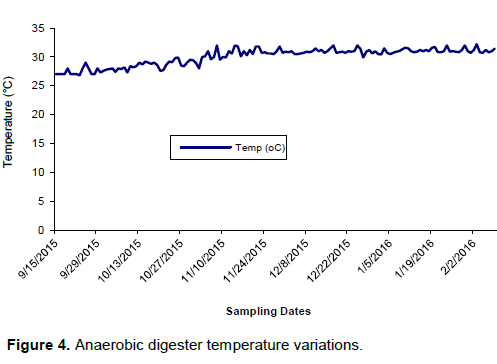ABSTRACT
Domestic wastewater treatment using constructed wetlands have been found to be very efficient and cost effective. Primary treatment facilities such as anaerobic digesters have been reported to reduce the organic load of wastewater before entering the constructed wetland systems. It has also been established that biogas is a product of organic matter decomposition under anaerobic condition. In this study, we evaluated quantity of biogas produced from the anaerobic digester of a constructed wetland domestic wastewater treatment plant. After a period of 148 days (15th September, 2015 to 8th February, 2016), the mean of the percentages of methane (CH4), Carbon dioxide (CO2), Hydrogen Sulphide (H2S) and Carbon monoxide (CO) were 60.97±8.38, 33.93±6.31, 1.03±4.45 and 0.25±2.11% respectively. The average rate of production of biogas was found to be 641.83±88.26 m3/day. The study concludes that anaerobic digester pre-treatments do not only assist in reducing organic load for the efficient performance of the constructed wetland but can also serve the purpose of biogas production. It is recommended that further works be carried out to determine the potential of energy recoverable from the anaerobic digester.
Key words: Anaerobic digester, biogas, constructed wetland, domestic sewage, renewable energy.
Various technologies have been introduced for the treatment of municipal, domestic, industrial, and nuclear wastewater. The fundamental procedures being used in these innovative wastewater treatment technologies are physical, chemical, and biological (Sehar et al., 2013). Domestic wastewater treatment using constructed wetlands have been found to be very efficient and cost effective especially in developing countries (Mahmood et al., 2013). Pre-treatment facilities such as anaerobic digesters have been reported to reduce the organic load of wastewater before entering the constructed wetland systems. It has also been established that biogas is a product of organic matter decomposition under anaerobic conditions. It has been observed that the absence of pre-treatment have adverse effect on the efficiency and performance of such CWWTPs. The first cell of such CWWTPs soon becomes clogged with heavy organic and non-organic loading. The result is reduction in performance efficiency, clogging of the first cell and the need to regularly dislodge the constructed wetland beds, thus increasing operational costs (Adeniran and Aina, 2015). Untreated domestic wastewater contains high levels of pollutants and creates major environmental problems when discharged into land or water bodies. The domestic wastewater contains pathogen which leads to the spread of diseases and odour, when discharged in water bodies or on land for irrigation without any treatment. It also contains chlorides, very small amount of solids, oils, fats and detergents and sanitizing agents, as such it requires treatment (Cheerawit et al., 2012; Metcalf and Eddy Inc., 2004). Central to wastewater treatment is the removal of organic matter occurring in the biological unit of the plant. This is usually performed by microbes that degrade the organic matter under controlled anaerobic conditions. However, this produces sludge of the resulting biomass from the microbes (biological sludge) in addition to the sludge produced in the primary treatment unit (primary sludge). This sludge must undergo further treatment and disposal and can account for up to 60% of the operating costs of a wastewater treatment plant (Davis and Hall, 1997; Di Iaconi et al., 2010). In an oxygen free environment, anaerobic microbes such as, methanogenic bacteria, acetogenic bacteria and fermentative bacteria, digest biodegradable matter into biogas with methane as potential energy content, carbon dioxide and other gases in small amount. This process is highly complex, and involves a number of sequential and parallel steps (Li et al., 2011). Degradation of unwanted components/contaminants in the anaerobic treatment chamber depends on several parameters such as temperature, pH, organic loading rate (OLR), hydraulic retention time (HRT), sludge retention time (SRT) and influent characteristics such as particle size distribution. The anaerobic digestion of organic material basically follows the order: Hydrolysis, acidogenesis, acetogenesis and methanogenesis (Ofoefule et al., 2009). Biogas produced by anaerobic process is a mixture of methane (CH4) carbon dioxide (CO2), nitrogen (N2) and some trace gases of which hydrogen sulphide (H2S) is the most evident (IPCC, 2001). Biogas is rich in methane and can be used directly for heating purposes, cooking, lighting and power generation (Olowoyeye, 2013). It is flammable and on combustion produces a blue flame which can reach a temperature of 1400°C (Hassan et al., 2015). The aim of this study is to determine the biogas production capability of the anaerobic digester pre-treatment of a constructed wetland domestic wastewater treatment plant.
Study area
The University of Lagos where this research was carried out is located in the Mainland of Lagos, the commercial capital of Nigeria. Lagos, the biggest and most important city in Nigeria has been classified as a mega city with a population of over 10 million. It is located on 06°25’N 03°27’E on the West African Coast with an average temperature 32°C and an annual mean rainfall 1532 mm. The University of Lagos has a day population of about 55,000 (Kadri and Associates, 2016). The entire population of the University campus engage in various domestic activities that generate solid wastes and wastewater.
Part of the wastewater generated in the University is treated through biological method using constructed wetland (CW) technology. The constructed wetland is pre-treated through primary treatment processes including purposely designed oxidation tank, trash screen and a anaerobic digester. The circular oxidation tank receives the free falling raw wastewater for natural air mixing. The screen removes the hard solids, trash and metallic objects. The digester is achieved in waterproof reinforced concrete. The sewage flows through the Cell No. 1 to Cell No. 7 of the subsurface flow CW system connected in series and planted with macrophyte (Cyperus papyrus). The final effluent water is further treated through a slow sand filtration system and reclaimed water is stored for re-use. Each of the cell of the CW is provided with dislodge valves to ensure regular dislodging of sediment from the cells especially during harvesting when the macrophytes are showing aging and withering. All the sludge end up in the Sludge Drying Bed while the effluent of the CW are stored in the Reclaimed Water Tank. The layout of the constructed wetland including the anaerobic digester is as shown in Figure 1.

Anaerobic digester configuration
The anaerobic digester for this study has a prismatic configuration with a total volume of 180 m3. The volume determination, carried out before the commencement of this study, was based on the average daily sewage flow rate (Qs), sludge settlement volume (Vs), digestion volume (Vd), gas storage volume (Vst), accumulation period (AP) and hydraulic retention time (HRT) (Modjinou, 2014). The relational equations used were proposed by Guozhong (2010) as shown in Figures 1 to 4.

Where: V = total volume of digester (m3); Vs = sludge settlement volume (m3); Vd = Digestion Volume (m3); Vst = gas storage volume (m3); Qs = Sewage flow rate (m3/day); HRT = hydraulic retention time (days); AP = accumulated period = Disludging frequency - digestion time (days) Equations 1 to 4 was the basis for sizing the anaerobic digester. A prismatic configuration of 10.0 m × 9.0 m × 2.0 m was selected based on an average sewage flow rate of 15 m3/day, hydraulic retention time of 10 days, desludging frequency of 21 days and biogas digestion time of 9 days (gestation period). A section through the anaerobic digester is shown in Figure 2.
Characteristics of domestic waste water
The domestic waste water was analysed for various parameters prior to entry into the anaerobic chamber. Analyses of each of the selected parameters (sulphate, manganese, dissolved oxygen, iron, nitrate and phosphate) were carried out with the use of Hach DR900 multi-parameter photometer. For each of the chemical parameters, 10 ml of the sample was dispensed into the cuvettesand the corresponding chemical reagents added (according to the manufacturer’s specification). Corresponding measurements were read-off the LCD display. The conductivity, pH and total dissolved solids (TDS) were also measured using the Adwa conductivity meter, Hanna microprocessor turbidity meter, Beckman 350 pH meter and HM digital TDS meter, respectively.
Biogas analysis
Gas outlets were created in the anaerobic pre-treatment chamber of the domestic sewage treatment plant and the percentage concentrations of methane, carbon dioxide, hydrogen sulphide and carbon monoxide were determined using the Gas Data GFM 406 Gas Analyser. Daily sampling was done in triplicates for a period of 148 days and the averages recorded. Statistical analysis of means and standard deviations was carried out on the data obtained using Microsoft Excel. The pressure and temperature in the anaerobic digester during study was monitored with a digital pressure gauge and thermometer from the outlets provided on the anaerobic digester. The gas flow rate was monitored using the gas flow meter.
Characteristics of influent wastewater into the anaerobic digester
The characteristics of domestic sewage as influent to the anaerobic digester was analysed and the mean values of the results are shown in Table 1.

The pH obtained (7.30) was within the range of values obtained (7.44 to 8.2) by Bodhke (2009) and Ismail et al. (2012). The domestic waste water has high content of dissolved materials as indicated in the conductivity and TDS values (1.11 mS and 717 mg/L, respectively). The presence of free oxygen in water is an indication of the ability of that water to support biological life. Ademoroti (1996) noted that healthy body of water should have dissolved oxygen of at least 5.2 mg/L. Low oxygen concentration is associated with heavy organic matter contamination (Prasad et al., 2006). The dissolved oxygen of the domestic wastewater in this study is low (2.65 mg/L) and the organic matter concentration observed from the study was also relatively high (Sulphate: 76.94 mg/L; Manganese: 9.56 mg/L; Iron: 2.43 mg/L and Nitrate: 33mg/L). Although sulphate is classified as non toxic constituent of water, intake of water containing high sulphate content can cause diarrhoea.
Biological Oxygen Demand (BOD) is the measure of the oxygen required by microorganisms whilst breaking down organic matter. The BOD obtained for the domestic wastewater in this study (85.47 mg/L) is moderate and hence the organic loading is suitable for the production of biogas under anaerobic condition.
Biogas production
The mean of daily biogas percentage production, temperature, pressure and gas flow rate (with standard deviation, maximum and minimum values) for 148 days is as shown in Table 2. Figure 3 shows the mean trends of production of the gasses relative to each other. The observed temperatures and pressures are also presented in Figures 4 and 5, respectively. The mean daily flow rate for the period was found to be 641.83 m3/day.




Generally temperature has a significant effect on the intracellular and extracellular environment of bacteria, and it also acts as an accelerator in the conversion processes. The temperature range within the digester fluctuated between 27.14 and 31.26°C. Temperature was observed to increase steadily with time as shown in Figure 4. Methane production in the anaerobic chamber of the domestic sewage treatment plant increased rapidly initially from 13.9 to 59.77% within a gestation period of 9 days. A further production increase to 64.9% was observed after which the methane production became almost constant (ranging between 66.0 and 67.5%) (Figure 6). It is observed that as the production of methane increases, the production of Carbon dioxide decreases (Figure 3).

Carbon dioxide composition of the biogas produced from the anaerobic chamber increased steadily with time from 10.30 to 40.3% after which observed production reduced gradually to 29.28% (Figure 7). As seen in Figure 3, the production of methane increases as the production of Carbon dioxide decreases. It is also observed that CH4 and CO2 constitute the major components of biogas from the anaerobic digester.
Hydrogen sulphide (H2S)% production trend of biogas In the anaerobic digester is as shown in Figure 8.
Although H2S is present in the gas mixture in little quantities, its presence is of great concern because of the odour, corrosive and hazardous properties (Bowker et al., 1989). H2S concentration in this study reduced initially from 18.34 to 0%. It was observed that as the methanogenic activities increases the H2S content of the biogas reduces to zero (Figure 3).
Carbon monoxide composition (%) of biogas in the anaerobic digester decreased sharply from 25 to 0.0%
after which a steady decrease was noticed (Figure 3).
The anaerobic digestion process can be summarized into for distinct stages: Hydrolysis, acidogenesis, acetogenenesis and methanogenesis (Tchobanoglous et al., 1993; Schirmer et al., 2014). During the methanogenic phase, after the acid phase, the methane concentration becomes high. Also, at methanogenesis phase, the acidity reduces and the H2S and CO are converted into CH4 and CO2. As an odorant gas in its molecular form, H2S formation is inhibited. Under anaerobic conditions, the methane concentration increases and the carbon dioxide decreases (Figure 6 and Figure 7). Also the H2S (Figure 8) sulphate is reduced to sulphide through the action of sulphate reducing bacteria (Gostelow and Parsons, 2001). As observed in Figures 6 the CO (Figure 9) reduces to zero at the early part of the anaerobic digestion process.
It is concluded from this study that appreciable amounts of methane gas can be obtained from the anaerobic pre-treatment digester of domestic sewage treatment plants. The gas obtained can be used as energy source to power the constructed wetland system which requires some level of power especially for the central sewer pumps, the reclaimed water recycling pumps and for lightning. It was observed that as methane concentration increased, Carbon dioxide and hydrogen sulphide concentration decreased. Further studies will focus on generating more methane through addition of inoculants, purifying the gas obtained and the determination potential of energy obtainable from the purified biogas.
The authors have not declared any conflict of interests.
REFERENCES
|
Ademoroti CMA (1996). Environmental Chemistry and Toxicology, Foludex Press Ltd. Ibadan Nigeria, pp. 134-146.
|
|
|
|
Adeniran AE, Aina AT (2015). The influence of anaerobic digester as a pre-treatment process for constructed wetland domestic sewage treatment plant, Int. J. Environ. Sci. Toxicol. Res. 3(2):29-42.
|
|
|
|
|
Bodhke SY (2009). A modified anaerobic baffled reactor for Municipal Wastewater treatment plant. J. Environ. Manag. 90:2489-2493.
|
|
|
|
|
Bowker RPG, Smith JM, Webster NA (1989). Odour and Corrosion Control in Sanitary Sewerage Systems and Treatment Plants. Hemisphere Publishing Corporation. pp. 15-20.
|
|
|
|
|
Cheerawit R, Thunwadee TS, Duangporn K, Tanwat R, Wichuda K (2012). Biogas Production from Co-digestion of domestic wastewater and food waste. Health Environ. J. 3(2):1-9.
|
|
|
|
|
Davis RD, Hall JE, (1997). Production, treatment and disposal of wastewater sludge in Europe from a UK perspective. Eur. Water Pollut. Contr. 7:9-17.
|
|
|
|
|
Di Iaconi C, De Sanctis M, Rossetti S (2010). SBBGR technology for minimizing excess sludge production in biological processes. Water Res. 44:1825-1832.
Crossref
|
|
|
|
|
Gostelow P, Parsons SA (2001). Hydrogen Sulphide Measurement. In: Stuetz R, Frechen FB, (Ed.), Odours in Wastewater Treatment - Measurement, Modeling and Control. London: IWA Publishing, pp. 120-129.
|
|
|
|
|
Guozhong S (2010). Design and Construction of Rural Household Hydraulic Biogas Digester, BIOMA, China. pp. 2-38.
|
|
|
|
|
Hassan KJ, Zubairu MS, Husaini I, (2015). Biogas Production Using Cow Dung, Poultry Waste and Yam Peels. Int. J. Environ. Bioenergy 10(2):107-114.
|
|
|
|
|
IPCC (2001). Climate Change: The Scientific Basis. Intergovernmental Panel on Climate Change.
|
|
|
|
|
Ismail MI, Fawzy AS, Abdel-Monem NM, Mahmoud MH, El-Halwany MA (2012). Combined coagulation flocculation pre-treatment unit for municipal wastewater. J. Adv.Res. 3(4):331-336.
Crossref
|
|
|
|
|
Li J, Jha AK, He J, Ban Q, Chang S, Wang P (2011). Assessment of the effects of dry anaerobic co-digestion of cowdung with waste water sludge on biogas yield and biodegradability. Int. J. Phy. Sci. 6(15):3723-3732.
|
|
|
|
|
Mahmood Q, Pervez A, Zeb BS, Zaffar H, Yaqoob H, Waseem, M, Zahidullah, Afsheen S (2013). Natural Treatment Systems as Sustainable Ecotechnologies for the Developing Countries. BioMed. Res. Int. pp. 1-19.
Crossref
|
|
|
|
|
Metcalf and Eddy Inc. (2004). Wastewater Engineering Treatment and Reuse, 4th edition, McGraw – Hill Publishing, New York.
|
|
|
|
|
Modjinou M (2014). Domestic Septic Tanks for Treating Sewage and Biogas Generation. Columbia University Academic Commons.
|
|
|
|
|
Ofoefule AU, Uzodinma EO, Onukwuli OD (2009). Comparative study of the effect of different pretreatment methods on biogas yield from water Hyacinth (Eichhornia crassipes). Int. J. Phys. Sci 4(8):535-539.
|
|
|
|
|
Olowoyeye J (2013). Comparative studies on biogas production using six different animal dung, J. Biol. Agric. Healthcare 3(15):7-10.
|
|
|
|
|
Prasad G, Rajeev R, Chopra AK (2006). Sand Intermittent Technology
Crossref
|
|
|
|
|
Schirmer WN, Jucá, JFT, Schuler ARP, Holanda S, Jesus LL (2014). Methane production in anaerobic digestion of organic waste from Recife (Brazil) landfill: evaluation in refuse of different ages. Braz. J. Chem. Eng. 31(2):373-84.
Crossref
|
|
|
|
|
Sehar S, Aamir R, Naz I, Ali N, Ahmed S (2013). Reduction of contaminants (Physical, Chemical and Microbial) in Domestic Waste water through Hybrid Constructed Wetland. ISRN Microbiol. pp. 1-10.
Crossref
|
|
|
|
|
Tchobanoglous G, Theisen H, Vigil SA (1993). Integrated solid waste management. Engineering principles and management issues. Irwin McGraw-Hill.
|
|